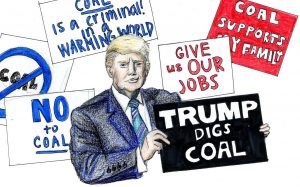Recent changes made to the Endangered Species Act by the Trump administration spark controversy
October 6, 2019
The Trump administration announced in August revisions to regulations that implement portions of the Endangered Species Act (ESA). These revisions have sparked controversy over their effect on different species.
What is the ESA?
Administered by the U.S. Fish and Wildlife Service and the National Marine Fisheries Service, the ESA was originally signed into law, with wide bipartisan support, in 1973 by President Richard Nixon. The purpose of the act is to protect endangered and threatened species and their environment and to stop the loss of animal and plant life.
“The Endangered Species Act limits and regulates the hunting and transport, of species that are classified as endangered. There’s more limited protection for species that are classified as threatened,” Ms. Annie Nguyen, an AP Environmental Science teacher at Dougherty, stated. “It also has to do with the transport of that species from one state to another. But being an act, that also means it’s only within the United States. It does not pertain to any protection outside of the U.S.”
Since it was enacted, the ESA has protected animals such as grizzly bears, humpback whales and bald eagles from extinction.
“The US Endangered Species Act (ESA) is our nation’s most effective law to protect at-risk species from extinction, with a stellar success rate: 99% of species listed on it have avoided extinction,” the World Wildlife Fund states.
How is the ESA changing?
Earlier in August the Trump administration announced changes that would essentially weaken the Endangered Species Act. The new rules imposed now make it easier for the government to remove endangered species from protection. Some of the changes that the administration imposed include:
- Incorporation and consideration of economic factors when categorizing endangered and threatened species, such as the cost of protecting species.
- Species categorized under “Threatened” will not recieve the same protection as those listed under “Endangered.”
- A loosened interpretation of the phrase “forseeable future” which impacts species that are affected by climate change
Environmental activsits and groups across the nation have been voicing their opinions, arguing that these changes to the legislation will impact the environment and result in further extinction issues.
“We’re facing an extinction crisis, and the administration is placing industry needs above the needs of our natural heritage,” Rebecca Riley, legal director of Nature Program Natural Resources Defense Council, states.
Many are concerned that these changes will only result in short-term economic benefits, while weakening the act can speed up the already-worrying loss of biodiversity.
Drew Caputo, Vice President of Litigation for Lands and Wildlife and Oceans at Earthjustice, comments, “There can be economic costs to protecting endangered species. If we make decisions based on short-term economic costs, we’re going to have a whole lot more extinct species.”
Where’s the controversy?
Many environmental protection groups and conservationists throughout America have criticized the Trump administration for the recent changes of the ESA. Earthjustice, a nonprofit environmental law organization, has filed a lawsuit on behalf of the Center for Biological Diversity, Defenders of Wildlife, Sierra Club, Natural Resources Defense Council, National Parks Conservation Association, WildEarth Guardians, and the Humane Society of the United States.
Their case rests on three main claims:
- “The Trump administration failed to publicly disclose and analyze the harms and impacts of these rules, in violation of the National Environmental Policy Act.”
- “The administration inserted new changes into the final rules that were never made public and not subject to public comment, cutting the American people out of the decision-making process.”
- “The administration violated the language and purpose of the Endangered Species Act by unreasonably changing requirements for compliance with Section 7, which requires federal agencies to ensure that actions they authorize, fund, or carry out do not jeopardize the existence of any species listed, or destroy or adversely modify designated critical habitat of any listed species.”
“This administration has a clear pattern of climate change denial and hostility to conservation,” Taylor Jones, endangered species advocate at WildEarth Guardians, stated. “We’re not going to let it stand. We’ll see them in court.”
Even outside of the lawsuit, others oppose the changes to the ESA.
“I think, generally speaking, relaxing the protections on endangered species… I don’t personally think is a good idea. We have been able to function and build our economies just fine without these pieces of legislation being so much more relaxed,” Nguyen said.
However, a press release by the U.S. Department of the Interior defends the changes.
“The revisions finalized with this rulemaking fit squarely within the President’s mandate of easing the regulatory burden on the American public, without sacrificing our species’ protection and recovery goals,” said U.S. Secretary of Commerce Wilbur Ross. “These changes were subject to a robust, transparent public process, during which we received significant public input that helped us finalize these rules.”
Furthermore, the administration claims that the new revisions improve the act’s effectiveness and ultimate goal of protecting and recovering different species.
“The Act’s effectiveness rests on clear, consistent and efficient implementation,” said U.S. Secretary of the Interior David Bernhardt. “An effectively administered Act ensures more resources can go where they will do the most good: on-the-ground conservation.”
Still, others warn of the harmful effects of such changes, both short-term and long-term.
“If we are removing species from ecosystems, there’s also that imbalance that might happen. If it’s a keystone species especially, there creates that sort of linchpin effect where, over a period of time, that ecosystem starts to collapse because it’s lost a regulatory species that was kind of maintaining the population above it and maintaining the population below it,” Nguyen said.
“There’s this idea that you should consider chain reactions befeore you make dramatic changes. There’s that short-term gain versus some long-term negative impacts that we’ll probably be seeing.”




